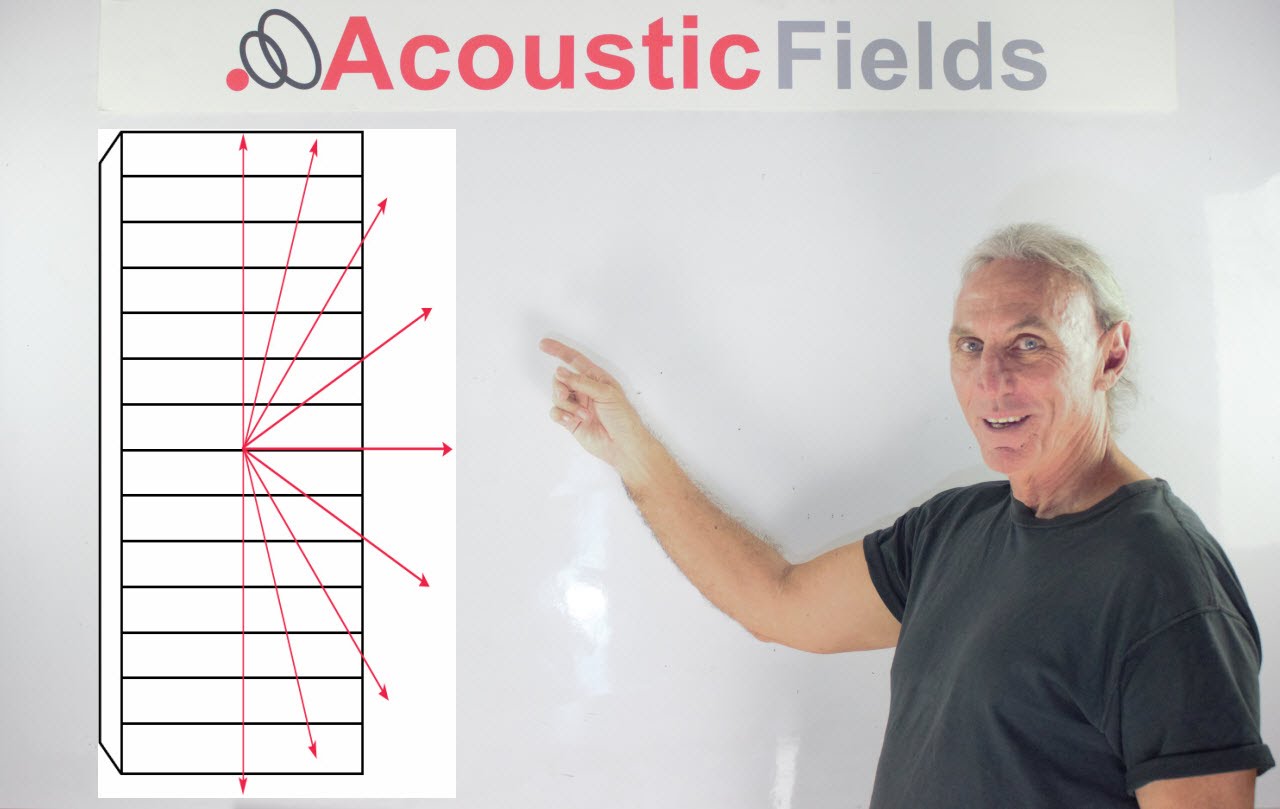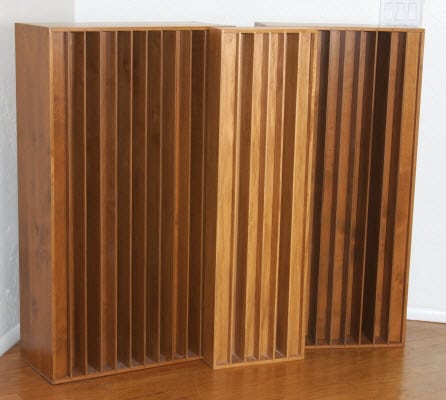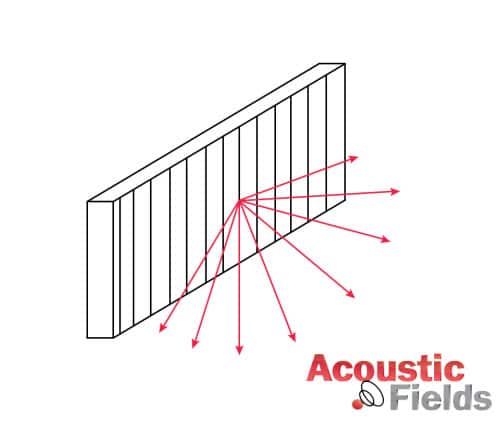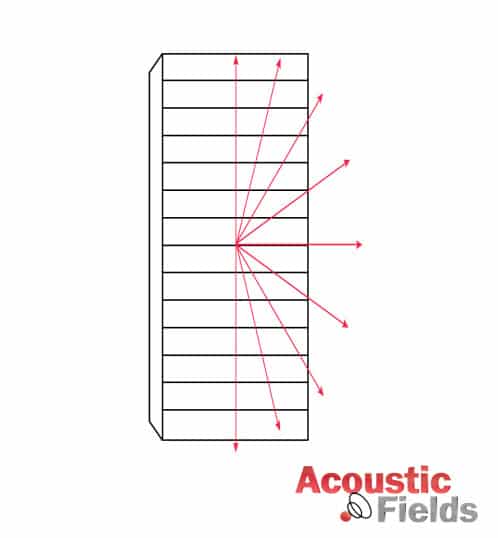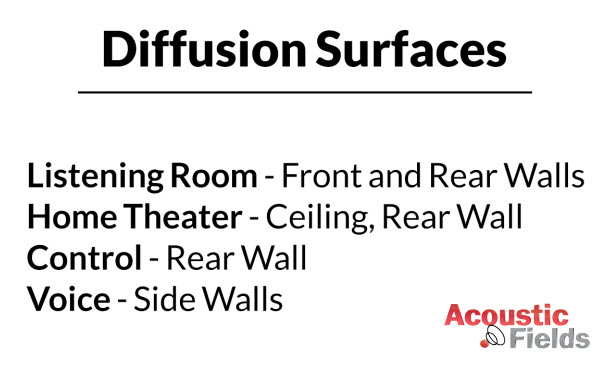Today we’re going to talk about diffusion because there’s a lot of confusion in diffusion. I don’t mean that comically by the way. You see I get a lot of questions everyday about diffusion and people just really don’t understand what a diffused sound field is and that’s what we’re talking about in our rooms. And those of you out there that think egg cartons are real diffusers, I think after we go through the six criteria need for a diffused sound field, you’ll see that that’s just simply not possible.
So what do we have to have to have a diffused sound field?
We have six criteria. We have to have no frequency or spatial irregularities in the response curve of the room. No gaps. We just have to have a nice, smooth frequency response. Secondly, the beats in the decay of the field within the room must be negligible. So we have to have a nice, smooth decay rate in the room. They must be exponential so they must be straight line. We have to have a nice, smooth decay. You know RT 60 time decay? They look like a straight line on a logarithmic scale so that’s nice, smooth linearity. And the reverb times, this is really important, must be the same for every position in the room. And the decay of those times must be the same for all frequencies.
So we have to have reverb times the same in all positions in the room and the character of the decay in every reverb time must be the same throughout the room. So, we have these six criteria that we must meet for a truly diffused sound field. Okay so how are we going to get that in our rooms?
Quadratic diffusion
Quadratic diffusion is the easiest, simplest way, a way you can do yourself. You can build a quadratic diffuser yourself. It’s predictable and consistent in its performance, its frequency response, so it’s a great tool to use. There are other kinds of diffusion that you can use but I think for most of our purposes, professional or amateur, quadratic diffusion works the best. We even have a series of kits you can buy. You can glue the pieces together yourself or you can build the unit yourself from drawings (you can see the options in our online shop here).
We’ve worked with quadratic diffusion for over 25 years. It’s predictable and consistent and those are the two biggest variables you have to have in a room acoustic product.
So what is a quadratic diffuser?
It’s a series of wells or troughs as shown in the below photo. They have different depths. The depth is based on quarter wavelength rule (you can see a video I made explaining about quarter wavelength rule here). So whatever the depth is, take that times four and that’s the frequency that’s being diffused or the frequency group. There’s groupings within each one of those troughs that are diffused.
Most quadratic diffusers range from 100 to 3400 cycles. Now, we know that a hundred hertz wave is 11-foot long so 25% of that, following the quarter wavelength rule, would be 3-feet. So this would be a really deep diffuser. I’ve built a few of these, they’re really hard to build but they’re marvelous. If you could diffuse energy down to a hundred cycles, that would be really good. Most diffusers that we work with are, for construction and build purposes, run from 375, 275, 375 to 3,400 cycles right in that critical mid-range. So the quadratic diffuser is a diffuser that can really give you a predictable and consistent performance in that frequency response rate.
Two ways to get a diffused sound field
So what do we have? We have three sound fields really that are in our room, height, width and length. Okay. So we can get two of those by using horizontal and vertical position diffuser. Same diffuser, just positioning it differently. And at the end of this post, I’m going to show to show you a graphic of how the sound field works with the vertical and a horizontal diffuser.
So, what is a good diffusion sequence to use in a room? It depends. It depends on your room, it depends on its usage, it depends on the size. So there’s a lot of variables to consider. The distance from the diffusion to the listening position is important. The distance from the diffuser to the speakers is also important. So a lot of variables must be taken into consideration.
So in the following graphic we have a vertical diffuser. You can see that it diffuses sound in a horizontal domain. So there’s an inverse relationship towards the position and performance.
In a horizontal diffuser we’re diffusing sound in a vertical way.
We have our two dimensions of sound diffusion in the same technology, just positioned differently. And then, in the following graphic, you see that different room usages require different diffusion placement. You see that with listening rooms, front wall and rear walls are always givens. For diffusion in a control room the rear wall is almost a given for diffusion.
So very few absolutes in room acoustics because of room usage. But in listening rooms and control rooms you can see in these graphics, diffusion is always welcome on those room surfaces.
In Summary
If you would like to learn more about room acoustics please sign up for my free videos and ebook by joining the mailing list here. I send room tuning tips and things for you to test in your room every Wednesday. They are easy to follow and will really help you enjoy more of your music.
Alternatively feel free to contact me directly at: 520 – 392 – 9486 MST or info@acousticfields.com. You can see more of my research and development story and why I started Acoustic Fields at: https://www.acousticfields.com/who-we-are/.
Thanks and speak soon
Dennis


